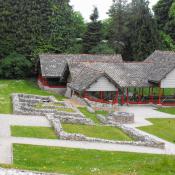Iron Age hillfort located just outside of Dorset. Maiden Castle is one of the largest and most complex such sites in Europe with rows of ramparts and an enclosure the size of 50 football pitches
Maiden Castle, in the parish of Winterborne Monkton near Dorchester, is one of the largest and most complex Iron Age hill forts in Europe. The fort sits on top of a hill that projects forty meters above the surrounding countryside.
The fort was constructed around 600 BC, although there is evidence of a Neolithic Causeway Enclosure on the site that dates back a further four thousand years. Arrowheads found in the ditches suggest that the enclosure met a violent end in around 3400 BC, after which the hill was used for agriculture and then abandoned until the Iron Age.
The original Iron Age fort enclosed a sixteen-acre area, surrounded by a single ditch. It quickly grew in size and stature. The ditch was extended to include the neighbouring Hog Hill and monumental defences were added, making Maiden Castle the largest Iron Age hill fort in Britain. Vast multiple ramparts enclosed an area the size of fifty football pitches that would have been home to several hundred people. There is evidence that iron slag was brought in from the South West and processed at Maiden Castle, which suggests that it was also one the most important iron production sites in southern Britain.
The eastern part of the hill fort remained in use for the first few decades of Roman occupation, although mutilated bodies in the 'war cemetery' suggest that the handover was far from peaceful. First century Roman artefacts found near the east entrance suggest that Maiden Castle could have been used as a Roman military outpost. It is thought that after the Roman attack any remaining inhabitants were forcibly removed to the Roman town of Durnovaria, now Dorchester.
It is possible that Maiden Castle later became the main settlement of a Celtic tribe called the Durotriges that rose to prominence in the second century. A Romano-Celtic temple was built sometime in the fourth century and a hoard of coins was discovered under the temple floor.
The modern name, which means 'fort that looks impregnable' was first recorded in 1607, spelt 'Mayden Castell'. Maiden Castle is protected as a scheduled ancient monument and maintained by English Heritage. A short, steep trail to the right of the car park leads through the original Iron Age entrance to the hill fort, a place of steep banks, deep ditches and irregular grassy surfaces.




